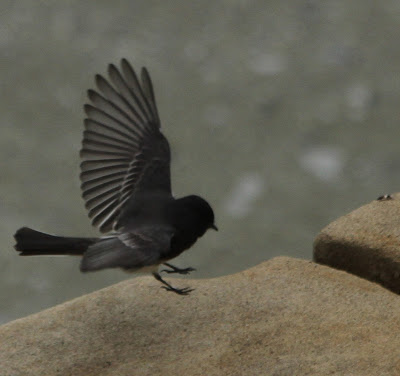Black Phoebes won my attention when we moved to an apartment complex during our home remodel several years ago. I discovered a park next door and spent an hour each day observing and writing about nature. I sat under a sycamore tree in late summer and observed.
Above my head, a black bird cleaned its beak. It flew to a lamp post and into the ivy behind me. Each day for a week, I watched this fellow in action.
One day I brought a seed bell and hung it under the bird's sycamore branch thinking I'd attract even more of its friends.
One day I brought a seed bell and hung it under the bird's sycamore branch thinking I'd attract even more of its friends.
I searched the internet and discovered the Black Phoebe fit the description of the behavior I had observed. My seed bell must have caused a snicker in the bird community. Phoebe only catch and eat insects on the fly.
Called hawking, they fly from from sunrise to sunset eating with the tenacity of a hummingbird. I've seen them capture bees and moths for dining pleasure.
Called hawking, they fly from from sunrise to sunset eating with the tenacity of a hummingbird. I've seen them capture bees and moths for dining pleasure.
Phoebes move in a circular pattern in their territory and work harder than anyone I know. In the spring, they pair and create a nest from mud, one beakful at a time. The male stands guard and sits the nest in rotation with his mate.
I discovered the conical nest in the eaves of our apartment building. The next stage involved nesting behaviors.
Resident crows became aggressive causing both phoebes to take turns chasing them causing disruption to their feeding ritual.
I heard peepings but could not see how many chicks had arrived. Unfortunately, I left on a trip for two weeks.
Resident crows became aggressive causing both phoebes to take turns chasing them causing disruption to their feeding ritual.
I heard peepings but could not see how many chicks had arrived. Unfortunately, I left on a trip for two weeks.

Upon my return to the park, I did not see the pair I'd named Flash and Fee. The nest appeared vacant and no peepings sounded. I felt a sudden fear that the crows had taken over during my absence.
Then I looked at the center of the park to discover four phoebes. They took turns dancing on air. I crept closer and watched this marvel of flight training.
I searched my home neighborhood for Black Phoebes missing this daily association when we moved back.
Water features in my yard abound to attract my favorite Black Phoebes.
One day a breeding pair will return to capture my fascination.
One day a breeding pair will return to capture my fascination.
In Awe of a Black Phoebe










3 comments:
These are such fabulous photos! I saw a Black Phoebe when I was in Mountain View, CA in 2010, was already in love with it from your descriptions in words. These photos just add to that. Wonderful!
I live in Oakland and have fallen in love with a black phoebe we call Buddy. I am searching for ways to keep him coming back to our yard. Thank you for your post, it's great to see another black phoebe fan!
Laura, make sure you have a water source for him. Running water in a fountain may attract also. Since he catches bugs all day long, try attracting bugs to your yard. The female builds a nest beakful by beakful. In the city, look under house eaves. Watching nesting and fledging for phoebes is an experience.
Keep in touch!
Post a Comment